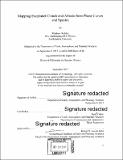Mapping exoplanet clouds and albedo from phase curves and spectra
Author(s)
Webber, Matthew (Matthew William)
DownloadFull printable version (11.91Mb)
Other Contributors
Massachusetts Institute of Technology. Department of Earth, Atmospheric, and Planetary Sciences.
Advisor
Kerri Cahoy.
Terms of use
Metadata
Show full item recordAbstract
This thesis uses planetary albedo models to investigate variations in visible wavelength phase curves of exoplanets. We improve upon existing exoplanet giant planet albedo models and incorporate exoplanet general circulation models to analyze the composition and occurrence of clouds on tidally locked exoplanets. We confirm that non-uniform cloud coverage on the dayside of tidally locked exoplanets will affect the magnitude and location of the maximum of the phase curve. We then apply the models to the exoplanet Kepler-7b and consider the effect of varying cloud species, sedimentation efficiency, particle size, and cloud altitude. In the context of Kepler Space Telescope observations, we show that the cloud compositions and spatial distributions can be constrained. We also investigate exoplanet HD189733b, modeling its clouds, albedo and phase curves. We create 3D maps of cloud formation and analyze how cloud composition, spatial distribution, and temperature dependence affects albedo spectra for HD189733b. We use the modeled cloud patterns of spatially-varying composition and temperature to determine the observable albedo spectra and phase curves for HD189733b by fitting to the observations of Berdyugina et al. (2011), Evans el al. (2013), and Wiktorowicz et al. (2015). We show that these integrated albedo and general circulation models enable us to model non-uniform reflectivity due to exoplanet clouds, and to better interpret observations.
Description
Thesis: Ph. D. in Planetary Science, Massachusetts Institute of Technology, Department of Earth, Atmospheric, and Planetary Sciences, 2017. Cataloged from PDF version of thesis. Includes bibliographical references (pages 89-91).
Date issued
2017Department
Massachusetts Institute of Technology. Department of Earth, Atmospheric, and Planetary SciencesPublisher
Massachusetts Institute of Technology
Keywords
Earth, Atmospheric, and Planetary Sciences.